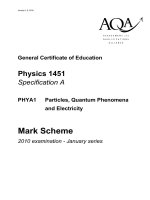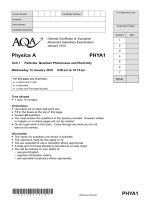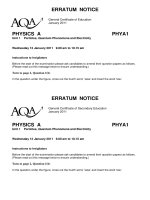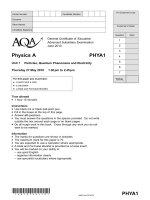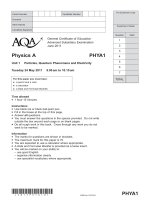- Trang chủ >>
- Khoa Học Tự Nhiên >>
- Vật lý
Vật lý A level:AQA PHYA1 w MS JAN11
Bạn đang xem bản rút gọn của tài liệu. Xem và tải ngay bản đầy đủ của tài liệu tại đây (178.79 KB, 8 trang )
Version 1.0
General Certificate of Education (A-level)
January 2011
Physics A
(Specification 2450)
PHYA1
Unit 1: Particles, quantum phenomena and
electricity
Final
Mark Scheme
Mark schemes are prepared by the Principal Examiner and considered, together with the relevant
questions, by a panel of subject teachers. This mark scheme includes any amendments made at the
standardisation events which all examiners participate in and is the scheme which was used by them
in this examination. The standardisation process ensures that the mark scheme covers the
candidates’ responses to questions and that every examiner understands and applies it in the same
correct way. As preparation for standardisation each examiner analyses a number of candidates’
scripts: alternative answers not already covered by the mark scheme are discussed and legislated for.
If, after the standardisation process, examiners encounter unusual answers which have not been
raised they are required to refer these to the Principal Examiner.
It must be stressed that a mark scheme is a working document, in many cases further developed and
expanded on the basis of candidates’ reactions to a particular paper. Assumptions about future mark
schemes on the basis of one year’s document should be avoided; whilst the guiding principles of
assessment remain constant, details will change, depending on the content of a particular examination
paper.
Further copies of this Mark Scheme are available from: aqa.org.uk
Copyright © 2011 AQA and its licensors. All rights reserved.
Copyright
AQA retains the copyright on all its publications. However, registered centres for AQA are permitted to copy material from this
booklet for their own internal use, with the following important exception: AQA cannot give permission to centres to photocopy
any material that is acknowledged to a third party even for internal use within the centre.
Set and published by the Assessment and Qualifications Alliance.
The Assessment and Qualifications Alliance (AQA) is a company limited by guarantee registered in England and Wales (company number 3644723) and a registered
charity (registered charity number 1073334).
Registered address: AQA, Devas Street, Manchester M15 6EX.
Mark Scheme – General Certificate of Education (A-level) Physics A – Unit 1: Particles, quantum
phenomena and electricity – January 2011
3
Instructions to Examiners
1 Give due credit for alternative treatments which are correct. Give marks for what is correct in
accordance with the mark scheme; do not deduct marks because the attempt falls short of
some ideal answer. Where marks are to be deducted for particular errors, specific instructions
are given in the marking scheme.
2 Do not deduct marks for poor written communication. Refer the scripts to the Awards meeting
if poor presentation forbids a proper assessment. In each paper, candidates are assessed on
their quality of written communication (QWC) in designated questions (or part-questions) that
require explanations or descriptions. The criteria for the award of marks on each such
question are set out in the mark scheme in three bands in the following format. The descriptor
for each band sets out the expected level of the quality of written communication of physics for
each band. Such quality covers the scope (eg relevance, correctness), sequence and
presentation of the answer. Amplification of the level of physics expected in a good answer is
set out in the last row of the table. To arrive at the mark for a candidate, their work should first
be assessed holistically (ie in terms of scope, sequence and presentation) to determine which
band is appropriate then in terms of the degree to which the candidate’s work meets the
expected level for the band.
QWC descriptor mark range
Good - Excellent
see specific mark scheme 5 – 6
Modest - Adequate
see specific mark scheme 3 – 4
Poor - Limited
see specific mark scheme 1 – 2
The description and/or explanation expected in a good answer should include a
coherent account of the following points:
see specific mark scheme
Answers given as bullet points should be considered in the above terms. Such answers
without an ‘overview’ paragraph in the answer would be unlikely to score in the top band.
3 An arithmetical error in an answer will cause the candidate to lose one mark and should be
annotated AE if possible. The candidate’s incorrect value should be carried through all
subsequent calculations for the question and, if there are no subsequent errors, the candidate
can score all remaining marks.
4 The use of significant figures is tested once on each paper in a designated question or part-
question. The numerical answer on the designated question should be given to the same
number of significant figures as there are in the data given in the question or to one more than
this number. All other numerical answers should not be considered in terms of significant
figures.
5 Numerical answers presented in non-standard form are undesirable but should not be
penalised. Arithmetical errors by candidates resulting from use of non-standard form in a
candidate’s working should be penalised as in point 3 above. Incorrect numerical prefixes and
the use of a given diameter in a geometrical formula as the radius should be treated as
arithmetical errors.
6 Knowledge of units is tested on designated questions or parts of questions in each a paper.
On each such question or part-question, unless otherwise stated in the mark scheme, the
mark scheme will show a mark to be awarded for the numerical value of the answer and a
further mark for the correct unit. No penalties are imposed for incorrect or omitted units at
intermediate stages in a calculation or at the final stage of a non-designated ‘unit’ question.
7 All other procedures including recording of marks and dealing with missing parts of answers
will be clarified in the standardising procedures.
Mark Scheme – General Certificate of Education (A-level) Physics A – Unit 1: Particles, quantum
phenomena and electricity – January 2011
4
GCE Physics, Specification A, PHYA1, Particles, Quantum Phenomena and Electricity
Question 1
(a) (i)
leptons do not experience the strong interaction but hadrons do
or hadrons not fundamental/made of quarks and leptons are not !
1
(a) (ii) hadron eg proton, neutron, pion !
2
lepton eg electron, neutrino !
(a) (iii) baryons !
3
mesons !
baryons made from three quarks (or 3 antiquarks), mesons a quark,
antiquark pair or baryons, baryon number is +1 or –1 mesons 0 !
(b) baryon number, lepton number, charge, strangeness, energy or momentum !
2
demonstration of conservation (before and after considered and number
appropriate to particle quoted) !
Total 8
Question 2
(a) (i) 88 protons !
3
140 neutrons !
88 electrons !
(a) (ii) electron !
1
(a) (iii)
Ra
!!
""!
# Ac
!$
""!
% e
&'
(
% )
*
+
!!!!
4
(b) 228 ± 10 !
2
88 !
Total 10
Question 3
(i) pair production !
1
(ii) conservation law stated (charge or lepton number) !
2
shown to be true eg lepton number +1–1 = 0 !
(iii) energy = 2 × 0.510 (ignore sfs) !
1
(iv) E = (1.02 × 1.6 × 10
–13
) = 1.63 × 10
–13
!
4
1.63 × 10
–3
= 6.63 × 10
–34
× 3.00 × 10
8
/λ !
λ = 6.63 × 10
–34
× 3.00 × 10
8
/1.63 × 10
–13
= 1.22 × 10
–12
m !
3 significant figures !
(v) will encounter an electron and the two particles will annihilate !
2
releasing (two high energy/gamma) photons/quanta !
Total 10
Mark Scheme – General Certificate of Education (A-level) Physics A – Unit 1: Particles, quantum
phenomena and electricity – January 2011
5
Question 4
(a)
The candidate’s writing should be legible and the spelling, punctuation
and grammar should be sufficiently accurate for the meaning to be
clear.
max 6
The candidate’s answer will be assessed holistically. The answer will be
assigned to one of the three levels according to the following criteria.
High Level (good to excellent) 5 or 6 marks
The information conveyed by the answer is clearly organised, logical and
coherent, using appropriate specialist vocabulary correctly. The form and
style of writing is appropriate to answer the question.
The candidate provides a comprehensive and coherent description which
includes a clear explanation of threshold frequency and why this cannot be
explained by the wave theory. The description should include a clear
explanation of the photon model of light and this should be linked to the
observations such as threshold frequency, the lack of time delay or
mentions 1 to 1 interaction, the could not be explained by the wave model.
Intermediate Level (modest to adequate) 3 or 4 marks
The information conveyed by the answer may be less well organised and
not fully coherent. There is less use of specialist vocabulary, or specialist
vocabulary may be used incorrectly. The form and style of writing is less
appropriate.
The candidate provides an explanation of threshold frequency and work
function. The candidate explains the photon model of light and how this can
provide an explanation of threshold frequency, eg relates energy of photon
to frequency or talks about packets of energy.
Low Level (poor to limited) 1 or 2 marks
The information conveyed by the answer is poorly organised and may not
be relevant or coherent. There is little correct use of specialist vocabulary.
The form and style of writing may only be partly appropriate.
States what is meant by photoelectric effect. Knowledge of photons/packets
of energy.
The explanation expected in a competent answer should include a
coherent account of the significance of threshold frequency and how
this supports the particle nature of electromagnetic waves.
● threshold frequency minimum frequency for emission of electrons
● if frequency below the threshold frequency, no emission even if
intensity increased
● because the energy of the photon is less than the work function
● wave theory can not explain this as energy of wave increases with
intensity
● light travels as photons
● photons have energy that depends on frequency
● if frequency is above threshold photon have enough energy
● mention of lack of time delay
Mark Scheme – General Certificate of Education (A-level) Physics A – Unit 1: Particles, quantum
phenomena and electricity – January 2011
6
(b) (i)
use of E
k
=
'
"
mv
2
3
½ × 6.6 × 10
–27
! × v
2
= 9.6 × 10
–13
!
v
2
= 2.91 × 10
–14
(or v = √2.91 × 10
–14
) !
(v = 1.7 × 10
7
m s
–1
)
(b) (ii) (use of p = mv)
3
p = 6.6 × 10
–27
× 1.7 × 10
7
!
p = 1.1 × 10
–19
! kg m s
–1
/N s !
(b) (iii)
(use of λ =
,
)
2
λ = 6.63 × 10
–34
/1.1 × 10
–19
!
λ = 5.9 × 10
–15
m ! (6.03 × 10
–15
m)
Total 14
Question 5
(a)
the square root of the mean of the squares of all the values of the voltage in
one cycle !
1
or the equivalent dc/steady/constant voltage that produces the same
heating effect/power !
(b) (i) peak voltage = 230 × √2 !
2
peak voltage = 325 V (or 324 V) !
(b) (ii) average power = 230 × 0.26 = 60 W !
1
(c)
-400
-300
-200
-100
0
100
200
300
400
0 0.005 0.01 0.015 0.02 0.025
voltage/V
time/ms
4
shape and symmetrical with consistent values of x at y = 0 and consistent
y
max
(must be at least one cycle) !
appropriate scale y-axis !
correct peak values (to within one 2 mm square) !
correct period (accept 0.02 or 20) !
Total 8
Mark Scheme – General Certificate of Education (A-level) Physics A – Unit 1: Particles, quantum
phenomena and electricity – January 2011
7
Question 6
(a) current = 0.40 A !
1
(b) (i) resistance = 12/0.2 = 60 Ω !
1
(b) (ii) power = 12 × 0.2 = 2.4 W !
1
(c) resistance of filament increases or more collisions/scattering !
2
as temperature of filament increase or filament gets hot/heats (until reaches
thermal equilibrium) !
(d) (i) voltage of supply now shared by lamps or resistance increased !
2
hence current reduced !
(d) (ii) current through the lamps unchanged/stays the same !
2
as both connected directly to the supply or correct resistance argument !
(e) resistance of lamps will be lower when first switched on !
max 2
hence initial current will be larger !
sudden rapid change in temperature !
Total 11
Mark Scheme – General Certificate of Education (A-level) Physics A – Unit 1: Particles, quantum
phenomena and electricity – January 2011
8
Question 7
(a) (i) voltage = 0.01 × 540 = 5.4 V !
1
(a) (ii) voltage = 15 – 5.4 = 9.6 V !
1
(a) (iii) (use of resistance = voltage/current)
2
resistance = 9.6/0.01 ! = 960 Ω !
or R
T
= 15/0.01 = 1500 Ω !
R = 150 – 590 = 960 Ω !
or potential divider ratio !!
(a) (iv) (use of 1/R = 1/R
1
+ 1/R
2
)
2
1/960 = 1/200 + 1/R
2
!
1/R
2
= 1/960 – 1/1200
R
2
= 4800 Ω !
(b) (voltage of supply constant)
3
(circuit resistance decreases)
(supply) current increases or potential divider argument !
hence pd across 540 Ω resistor increases !
hence pd across 1200 Ω decreases !
or resistance in parallel combination decreases !
pd across parallel resistors decreases !
pd across 1200 Ω decreases !
Total 9

